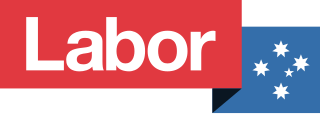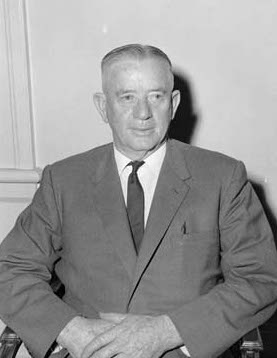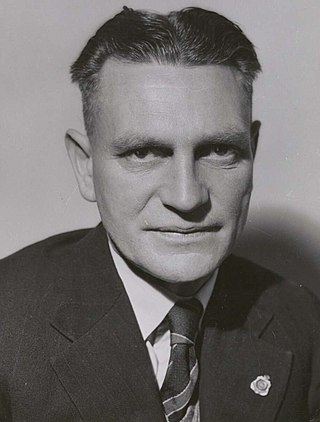
The Australian Labor Party (ALP), also commonly known as the Labor Party or simply Labor, is the major centre-left political party in Australia and one of two major parties in Australian politics, along with the centre-right Liberal Party of Australia. The party has been in government since being elected at the 2022 federal election, and with political branches in each state and territory, they currently form government in New South Wales, Queensland, South Australia, Victoria, Western Australia, the Australian Capital Territory, and the Northern Territory. As of 2023, Tasmania is the only state or territory where Labor forms the opposition. It is the oldest continuous political party in Australian history, being established on 8 May 1901 at Parliament House, Melbourne, the meeting place of the first federal Parliament.

Vincent Clair Gair was an Australian politician. He served as Premier of Queensland from 1952 until 1957, when his stormy relations with the trade union movement saw him expelled from the Labor Party. He was elected to the Australian Senate and led the Democratic Labor Party from 1965 to 1973. In 1974 he was appointed Australian Ambassador to Ireland by the Whitlam government, which caused his expulsion from the DLP.

The Democratic Labor Party (DLP) was an Australian political party. The party came into existence following the 1955 ALP split as the Australian Labor Party (Anti-Communist), and was renamed the Democratic Labor Party in 1957. In 1962, the Queensland Labor Party, a breakaway party of the Queensland branch of the Australian Labor Party, became the Queensland branch of the DLP.
The Labor Left, also known as the Progressive Left or Socialist Left, is a political faction of the Australian Labor Party (ALP). It competes with the more economically liberal Labor Right faction.

Francis Henry Walsh was the 34th Premier of South Australia from 10 March 1965 to 1 June 1967, representing the South Australian Branch of the Australian Labor Party.
The Industrial Groups were groups formed by the Australian Labor Party (ALP) in the late 1940s, by Catholic ALP members aligned with B. A. Santamaria's "Movement" within the ALP from 1944, to combat alleged Communist Party infiltration in the trade unions.
The Queensland Labor Party (QLP) was a political party of Queensland, Australia formed in 1957 by a breakaway group of the then ruling Labor Party Government after the expulsion of Premier Vince Gair. In 1962 the party became the Queensland section of the Democratic Labor Party (DLP). The party continued to hold seats in the Queensland state parliament until 1972, then suffered a collapse in its vote and wound itself up in 1978.

Standish Michael Keon was an Australian politician who represented the Australian Labor Party in the Federal Parliament from 1949 to 1955, having served previously in the State Parliament of Victoria.

Thomas Sheehan was an Australian politician. Born in Sydney, he attended Catholic schools before becoming an engine-driver and official of the Australian Federated Union of Locomotive Enginemen. He was involved in local politics as a member of Newtown City Council. In 1937, he was elected to the Australian House of Representatives as the Labor member for Cook. In 1940, when the New South Wales Caucus of the Labor Party split, Sheehan joined the Australian Labor Party (Non-Communist) under the leadership of Jack Lang. However, in 1941 John Curtin reunited the party, and Sheehan and the other Lang Labor members rejoined the federal ALP. He held the seat for the rest of his life. Thomas married Annie O'Mara and had four children, Stanley, Thomas, May and Kenneth.
John Thomas Kane was an Australian politician. Born in Burraga, New South Wales, he was educated at Catholic schools in Lithgow, after which he became a coalminer. He was vice-president of the Transport Workers' Union 1952–1956 and Assistant General Secretary of the New South Wales Labor Party 1952–1955. In 1955, he was expelled from the Labor Party together with many other members, joining with them to form the Australian Labor Party (Anti-Communist), which became the Democratic Labor Party (DLP). He was the NSW DLP General Secretary 1956–1971 and the Federal Secretary 1957–71.
John Albert Little was an Australian politician. Born in Maryborough, Victoria, he was educated at East Brunswick and Thornbury state primary Schools, before becoming a clicker in a shoe factory in Collingwood, and later an official with the Victorian Boot Employees' Union, of which he was Federal President in 1944 and 1945. In 1952, was awarded a Commonwealth Bank Scholarship for six months, to study unionism and working conditions in the UK, Europe and the US. In 1954, he was elected to the Victorian Legislative Council for Melbourne North, representing the Labor Party.

George Ronald Cole was an Australian politician who served as a Senator for Tasmania from 1950 to 1965. He was initially elected to parliament as a member of the Australian Labor Party (ALP). He joined the Australian Labor Party (Anti-Communist) after the party split of 1955, which became the Democratic Labor Party (DLP). He served as the DLP's parliamentary leader until losing his seat at the 1964 election.
This is a list of members of the Australian Senate from 1956 to 1959. Half of its members were elected at the 9 May 1953 election and had terms starting on 1 July 1953 and finishing on 30 June 1959; the other half were elected at the 10 December 1955 election and had terms starting on 1 July 1956 and finishing on 30 June 1962. The process for filling casual vacancies was complex. While senators were elected for a six-year term, people appointed to a casual vacancy only held office until the earlier of the next election for the House of Representatives or the Senate.
Frank Outen Jensen Purdue, was an Australian politician. He was a member of the New South Wales Legislative Assembly from 1956 until 1962 and again between 1964 and 1965. He was prominent in local Government and was Lord Mayor of Newcastle, NSW for 9 years between 1951 and 1965. He was not aligned to a political party.
Patrick Leslie Coleman CBE, Australian politician, was a member of the Victorian Legislative Council for Melbourne West Province representing the Labor Party from October 1943 until March 1955. He was a member of the Catholic Social Studies Movement in Victoria, and was expelled from the ministry and the ALP as part of the Australian Labor Party split of 1955. After his expulsion from the ALP in March 1955, he became, with Bill Barry in the Victorian Legislative Assembly, the parliamentary leader of the Australian Labor Party (Anti-Communist), which was briefly referred to in the media as the Coleman-Barry Labor Party. He was a member of that party only until June 1955.
William Peter Barry was a Member of the Victorian Legislative Assembly for the Electoral district of Carlton from July 1932 until April 1955. Barry was a member of the Labor Party until March 1955, when he was expelled from the party as part of the Australian Labor Party split of 1955. He became, with Les Coleman in the Victorian Legislative Council, joint leader of the Australian Labor Party (Anti-Communist), a party that in 1957 became the Democratic Labor Party.
Francis Raymond Scully, Australian politician, from 1949 was a member of the Victorian Legislative Assembly for the electoral district of Richmond representing the Labor Party to March 1955. He was Assistant Minister of Lands, Assistant Minister of Electrical Undertakings in the third Cain government from 1952 to 1955. He was a member of the Catholic Social Studies Movement in Victoria, and was expelled from the ministry and the ALP as part of the Australian Labor Party split of 1955. He then was a member of the Australian Labor Party (Anti-Communist) from 1955 to 1958. Scully was the only member of the DLP in the lower house of the Victorian parliament during these three years.
The Australian Labor Party split of 1955 was a split within the Australian Labor Party along ethnocultural lines and about the position towards communism. Key players in the split were the federal opposition leader H. V. "Doc" Evatt and B. A. Santamaria, the dominant force behind the "Catholic Social Studies Movement" or "the Movement".
Thomas William Brennan was an Australian politician.
Thomas Hayes was an Australian politician. He was the Labor Party member for Melbourne in the Victorian Legislative Assembly from 1924 to 1955.






